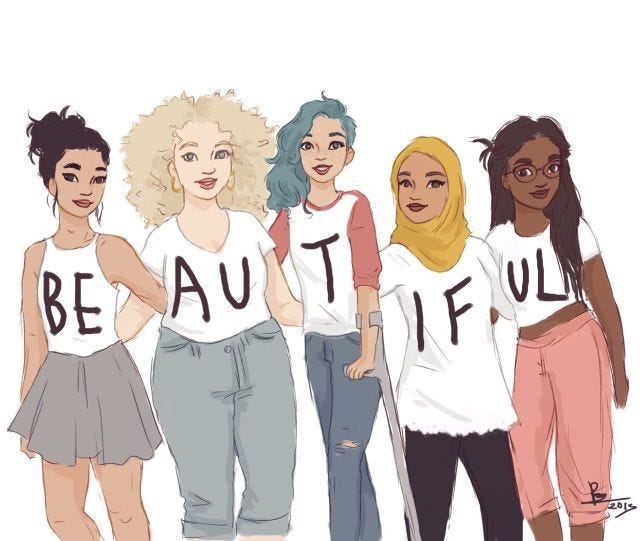When I Look In The Mirror
When I Look In The Mirror
In my personal life, I've always considered myself a feminine person. I like to wear flowing dresses and do my makeup, styling my hair in ways that are comfortable and beautiful. However, it wasn't until recently that I considered why I did all these things. I always thought that I did them solely for the purpose of making myself happy, but that might not be completely true. Perhaps, at some point, I continued leaning into my feminine self in order to fit into society's standard of femininity. As we will discuss in this post, this standard can be harmful and largely negative on young girls and women like myself and many others in the world.
As most people are aware of, the beauty standard pushed by the larger media world is one that doesn't entirely fit the reality that we live in. In most advertisements in modern America, models are "'beautiful,' thin... young, abled, smiling women" (Shaw & Lee 162). These women are also mainly white, and when they are not, they typically have more "white" features, hair, or lighter skin that could be considered "white-passing." This constant image of women featured in a lot of popular media suggests that it is supposed to be the standard for every woman and female-presenting person. As we all know, though, this is simply not true, as women of every shape, size, and color are all beautiful in their own right and should know that.
This standard is quite interesting in the larger context of the world as several places have different standards. What might be considered undesirable here is completely acceptable and praised somewhere else. Take, for example, body weight. Here in America, there is a constant emphasis on people, especially women, that being overweight is not good and should be something to be shamed for. However, some societies "consider large women especially attractive and see their fat as evidence of prosperity" (Shaw & Lee 163). Every society is different, but they all seem to idealize one image of the body over another.
For example, in today's modern world, the goal body type for a woman is to be thin. However, those thin women are also shown to be "large-breasted and full-bottomed, white (tanned, but not too brown)" (Shaw & Lee 164). This specific body type is incredibly rare, of course, as the more prominent bust and bottom also tends to come with larger hips and waists for a proper body proportion. This standard is reached through plastic surgery and, in the cases of some celebrities, passed off as natural growth. This is a harmful idea to spread to impressionable young women, who could believe this body type can be achieved through working out and dieting. When that doesn't work, they can become discouraged and unhappy with their body, which can lead to further mental health problems and possible disorders.
The big underlying message of the beauty standard, especially in the advertising and media industry, is that women must change themselves in order to be deemed "acceptable" by society. This kind of change isn't something that can come about naturally, but through the purchase of various products and procedures. Commercials for makeup brands and liposuction companies are frequent on my television, saying that women can be happier through partaking with their products. Those commercials and various other forms of media exist to say that "we are not good enough the way we are but need certain products to improve our looks and relationships" (Shaw & Lee 169). This standard applies to men as well, who are portrayed to be clean-shaven and slightly muscular with strong jaws. However, the scrutiny placed on the body isn't as strong on men as it is on women, as men aren't conditioned to fit into a certain ideal at a young age like women are.
Going into my personal experience with this is a little sensitive, as I still struggle with my body image to this day. I have a little sister who turned thirteen this year and I'm starting to see the way this standard of beauty affects her as well. She hasn't even finished developing and still scrutinizes her body based on her favorite actresses and musicians, something I've done for a long time as well. I tell her that she shouldn't do that and should be happy with herself, but some days it's hard for me to take my own advice.
Of course, all of this isn't to say that women shouldn't participate in wearing makeup, keeping up with fashion trends, or even getting surgeries to change their appearance. As long as those things are done in order to fulfill your personal happiness, and not to conform to the impossible beauty standards of the world, then I fully believe you should do as you please. The real standard of beauty should be how you hold yourself with confidence and present yourself as your true self, not what society wants you to be.
Torrisi, Juliet. “Body Image - Self Esteem - Influence of Society.” Medium, Medium, 8 June 2018, https://medium.com/@juliettorrisi1/body-image-self-esteem-influence-of-society-23c8e188a621.
Shaw, Susan M., and Janet Lee. Gendered Voices, Feminist Visions: Classic and Contemporary Readings. Oxford University Press, 2020.




Comments